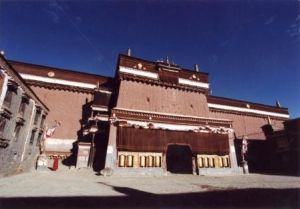Sakya Monastery
Sakya Monastery is at Sakya County, 130 km southwest of Xigaze, Tibet’s second largest city. Sakya Monastery is the ancestral temple of Sakya Sect of Tibetan Buddhism. It was built in 1073 during the Song Dynasty (960-1279) by Konchock Gyelpo, founder of the Sakya Sect. Its buildings are all painted dark gray, with white stripes along the tops of walls and red and white vertical stripes descending them. Each color has its own significance, the red, white and dark gray representing Manjushri, Avalokiteshvara and Vajrapani, respectively. For this reason, the Sakya Sect is commonly called the “Striped Sect.”
Sakya Monastery is divided into two parts: the Northern and the Southern monasteries. The former is on Bonpo Hill north of the Trom-chu River, and the latter on flat land south of the river. Its architecture is a harmonious combination of Chinese, Indian, Nepalese and Tibetan styles. Originally, the Northern Monastery was the larger, but now only ruins remain.
The Southern Monastery was built in 1286 by Ponchen Shakya Zangpo on the orders of Phagspa. This deep red, moat-surrounded “fortress,” occupies an area of 45,000 sq. m. The Lhakhang Chenmo (Assembly Hall) is its principal building. This enormous structure, measuring 84.8 m from north to south and 79.8 m from east to west, could accommodate 10,000 lamas at one time.
The Sakya Monastery has a collection of over 40,000 books. In addition to 10,000 scripture books, it has a large collection of astronomical and medical texts written on pattra leaves. These books are essential reading for Sakya monks and important materials for the study of Tibetan Buddhism.
